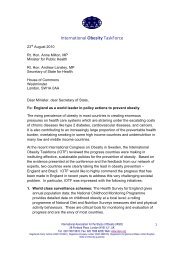COURSE GUIDE - International Association for the Study of Obesity
COURSE GUIDE - International Association for the Study of Obesity
COURSE GUIDE - International Association for the Study of Obesity
You also want an ePaper? Increase the reach of your titles
YUMPU automatically turns print PDFs into web optimized ePapers that Google loves.
Speaker Presentation Summarieswith different intensity and duration, on obstructive sleep apnoea.Below two cases from our study are presented. In our study weinvestigated <strong>the</strong> effect <strong>of</strong> a very low energy diet (VLED) <strong>for</strong> nineweeks 3 followed by a weight maintenance programme <strong>for</strong> a totalduration <strong>of</strong> one year in obese men with moderate to severeobstructive sleep apnoea.Case 1 The first case was a 43y old man with a body weight <strong>of</strong>126 kg and a BMI <strong>of</strong> 38.8 kg/m 2 . During <strong>the</strong> VLED phase <strong>the</strong>patient lost 30 kg, BMI was reduced to 29.5 kg/m 2 and AHI wasreduced from 37 to 12 events/h. Over <strong>the</strong> one year treatmentprogramme he lost 26% <strong>of</strong> his initial weight, AHI was improvedby 60% and he went from severe (AHI >30) to mild (AHI 5-15)sleep apnoea and no longer needed treatment with CPAP.Case 2 The second case was a 54y old man with a weight <strong>of</strong> 87kg and BMI <strong>of</strong> 32.1 kg/m 2 . During <strong>the</strong> VLED phase <strong>the</strong> patient lost14 kg, BMI was reduced to 26.9 kg/m 2 and AHI was reduced from56 to 21 events/h. Over <strong>the</strong> one year treatment programme he lost10% <strong>of</strong> his initial weight. His AHI improved by 66% and he wentfrom severe (AHI >30) to moderate (AHI 15-30) sleep apnoea.References1. Tuomilehto HP, Seppa JM, Partinen MM, Peltonen M, GyllingH, Tuomilehto JO, et al. Lifestyle intervention with weightreduction: first-line treatment in mild obstructive sleep apnea.Am J Respir Crit Care Med 2009;179(4):320-7.2. Foster GD, Borradaile KE, Sanders MH, Millman R, Zammit G,Newman AB, et al. A randomized study on <strong>the</strong> effect <strong>of</strong> weightloss on obstructive sleep apnea among obese patients withtype 2 diabetes: <strong>the</strong> Sleep AHEAD study. Arch Intern Med2009;169(17):1619-26.3. Johansson K, Neovius M, Lagerros YT, Harlid R, Rossner S,Granath F, et al. Effect <strong>of</strong> a very low energy diet on moderateand severe obstructive sleep apnoea in obese men: arandomised controlled trial. BMJ 2009;339:b4609.Arya SharmaWhen is surgical treatment <strong>for</strong> obesity appropriateBariatric surgery should be considered <strong>for</strong> obese patients at highrisk <strong>of</strong> morbidity and mortality who have not achieved adequateweight loss with lifestyle and medical management and who aresuffering from <strong>the</strong> complications <strong>of</strong> obesity. Bariatric surgerycan result in substantial weight loss, resolution <strong>of</strong> comorbidconditions, and improved quality <strong>of</strong> life. The patient’s weightlosshistory; his or her personal accountability, responsibility, andcomprehension; and <strong>the</strong> acceptable level <strong>of</strong> risk must be takeninto account. Complications include technical failure, bleeding,abdominal pain, nausea or vomiting, excess loose skin, bowelobstruction, ulcers, and anastomotic stricture. Success withbariatric surgery is more likely when multidisciplinary careproviders, in conjunction with primary care providers, assess,treat, monitor, and evaluate patients be<strong>for</strong>e and after surgery.Lifelong monitoring by a multidisciplinary team is essential.Family physicians will play a critical role in counselling patientsabout bariatric surgery and will need to develop skills in managing<strong>the</strong>se patients in <strong>the</strong> long-term.Lucy JonesCase studies: Weight loss be<strong>for</strong>e surgeryHere, we discuss 2 examples <strong>of</strong> where weight loss prior tobariatric surgery has been able to improve <strong>the</strong> treatmentpathway or patient outcome. Weight loss be<strong>for</strong>e surgery canimprove insulin sensitivity, cardio respiratory fitness, mobility,blood pressure and reduce dosages <strong>of</strong> various medications. Thisshould ensure that seriously challenged obese and super-obesepatient’s experience <strong>of</strong> surgery is less hazardous.Charles CapperThe challenges <strong>of</strong> weight management in primary carepractice<strong>Obesity</strong> in adults rose from 15% in 1993 to 24.5% in 2008. If itcontinues at this rate is predicted to rise to 50% by 2050.The challenges to prevention and treatment <strong>of</strong> obesity include:• Understanding <strong>the</strong> causes <strong>of</strong> <strong>the</strong> present epidemic such asabundance <strong>of</strong> calorie dense foods, poor food labelling, attraction<strong>of</strong> sedentary pursuits at <strong>the</strong> expense <strong>of</strong> activity, chaotic eatingpatterns and loss <strong>of</strong> nuclear family life.• Treating adult obesity with interventions that fit with pressures<strong>of</strong> modern living.• Identifying and treating childhood obesity since it is now wellaccepted that obese children become obese adults.• Awareness <strong>of</strong> <strong>the</strong> need to refer children earlier than at present.• Role <strong>of</strong> schools.• Understanding <strong>of</strong> <strong>the</strong> respective roles <strong>of</strong> aerobic and resistanceexercise and changing perceptions on exercise versus caloriecontrol.• Overcoming health pr<strong>of</strong>essionals’ reluctance to prescriberegimens to create weight loss in children <strong>for</strong> fear <strong>of</strong> negativeimpact on growth.• Addressing parental perceptions.• Improved local support services and role <strong>of</strong> government actionand public health measures.• Recognition by health pr<strong>of</strong>essional <strong>of</strong> obesity as a treatabledisease and overcoming perceived impotence in treating it.• Greater awareness <strong>of</strong> <strong>the</strong> role <strong>of</strong> very low calorie diets andbariatric surgery.• Greater emphasis on obesity in <strong>the</strong> medical school curriculumI hope to expand on <strong>the</strong> above, consider how primary carepractice can address <strong>the</strong>se challenges and encourage discussionwith regard to recent evidence in <strong>the</strong>se areas.Pia ChristensenBody composition changes and adverse effectsThere has been concern about <strong>the</strong> loss <strong>of</strong> lean body massduring Very Low Energy Diet (VLED) and Low Energy Diet (LED)treatments. Several studies have shown that with <strong>the</strong> use <strong>of</strong> LED’s,<strong>the</strong> lean body mass: fat-mass ratio <strong>of</strong> <strong>the</strong> lost mass is approximately25:75. The loss <strong>of</strong> lean body mass, in <strong>the</strong> osteoarthritis and weight24







